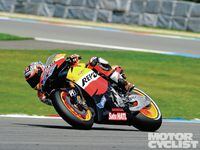A rider can ride any line he can see. Sounds simple enough, right? But while I can define all of the basics of lines in a 20-minute technical briefing and get 100 percent agreement on each point from every rider in the room, something goes very wrong between there and the asphalt.
Lines are definite and real, observable by anyone who is looking. Where did the rider enter the corner? Where did his tires pass over the pavement through the turn? Where did he finish it? These points are not subject to speculation; they can be seen, videoed and plotted precisely. Because such wild variations occur over and over, however, it is obvious that the rider making the errors cannot see them. Only one out of 10 riders feels confident that he has a “natural” sense of line. Therefore, translating the sense of line into action is something with which riders struggle. It all comes down to space and time.
What could be more important than answering the question of where am I now? And where will I be in the future? We need to know so we can easily respond safely, and create a clean, defined progression through the bend. Our location in space and time is an essential part of this.
Riding at a racetrack just shy of four lanes wide, it’s not uncommon to see students exit corners 10 feet from the inside edge of the pavement—leaving 30 feet of exit swing-out room unused. This gives us another glimpse of the mental and visual machinery at work, because that is bizarre behavior in that environment. It leaves a rider with a very short list of options.
Apparently, riders afflicted with this problem salivate at the idea of tight exit lines. On one level it makes sense: Their goal is a line that takes them as far from the other lane or shoulder of the road as possible. But that goal is governed by pain avoidance, not pleasure seeking. We know that because it’s far more satisfying to add throttle while exiting corners—letting the bike swing wide from it—and experience the pleasurable sensation of acceleration. Provided you don’t have some other responsibility, like a fearful passenger, this is true for every one of us.
In recent articles, I've given other ideas on how to use our primary space-identification equipment: our eyes. In this case, we must assume there is something horrible about the outside of turns. If that's true, we also know that, instinctually, we will tend to look for the danger. That creates a dilemma. If we are looking for the danger on the outside of the corner, then we would tend to go there—and some do. We go where we look.
On the other hand, riders with the tight-exit-line syndrome are clearly not doing that, and it can be stressful to ride like that.
The solution? If you can begin picking up the bike and rolling on the gas right after you’ve passed the apex of a turn, your line isn’t that bad. On the other hand, if you find yourself having to add or hold your lean angle for a while after the apex, you’ve blown it. It was a bad line and you’ve missed the fun bit. Be watchful and coordinate that moment when you can begin bringing the bike up, letting it run out wide and adding more throttle.











/cloudfront-us-east-1.images.arcpublishing.com/octane/HXOUJXQWA5HBHGRO3EMJIGFMVI.jpg)

/cloudfront-us-east-1.images.arcpublishing.com/octane/3TIWWRV4JBBOLDVGRYECVVTA7Y.jpg)
/cloudfront-us-east-1.images.arcpublishing.com/octane/KIX5O23D5NAIBGFXBN3327DKZU.jpg)
/cloudfront-us-east-1.images.arcpublishing.com/octane/7GJYDUIPXRGMTMQKN6ONYOLBOU.jpg)
/cloudfront-us-east-1.images.arcpublishing.com/octane/MUQLOVLL2ZDGFH25ILABNBXKTI.jpg)
/cloudfront-us-east-1.images.arcpublishing.com/octane/TNOU5DNE2BC57MFPMGN2EIDXAM.jpg)
/cloudfront-us-east-1.images.arcpublishing.com/octane/GTCXACQGJ5HAPDTGWUQKDEH44E.jpg)
/cloudfront-us-east-1.images.arcpublishing.com/octane/S35YGSEMEZB4BLTDJTSZPF4GLA.jpg)
/cloudfront-us-east-1.images.arcpublishing.com/octane/5UOT6HPX2JFMRJAX6EH45AR4MQ.jpg)
/cloudfront-us-east-1.images.arcpublishing.com/octane/OKWOJWAKP5EP3OACCRRWPCIX2Q.jpg)
/cloudfront-us-east-1.images.arcpublishing.com/octane/2WF3SCE3NFBQXLDNJM7KMXA45E.jpg)
/cloudfront-us-east-1.images.arcpublishing.com/octane/G4MG6OUCJNBSHIS2MVVOTPX65E.jpg)
/cloudfront-us-east-1.images.arcpublishing.com/octane/IIGGWFOTOJGB7DB6DGBXCCMTDY.jpg)
/cloudfront-us-east-1.images.arcpublishing.com/octane/QSTCM6AVEZA5JJBUXNIQ3DSOF4.jpg)
/cloudfront-us-east-1.images.arcpublishing.com/octane/U4I7G625B5DMLF2DVIJDFZVV6M.jpg)
/cloudfront-us-east-1.images.arcpublishing.com/octane/B6XD6LS6IVCQPIU6HXDJSM3FHY.jpg)
/cloudfront-us-east-1.images.arcpublishing.com/octane/ICL63FEDDRDTTMINYICCEYGMDA.jpg)
/cloudfront-us-east-1.images.arcpublishing.com/octane/FCGZHQXRBZFLBAPC5SDIQLVF4I.jpg)
/cloudfront-us-east-1.images.arcpublishing.com/octane/WNOB6LDOIFFHJKPSVIWDYUGOPM.jpg)

/cloudfront-us-east-1.images.arcpublishing.com/octane/X33NU3E525ECRHXLNUJN2FTRKI.jpg)
/cloudfront-us-east-1.images.arcpublishing.com/octane/6KKT5NNL2JAVBOXMZYS5ZO76YA.jpg)
/cloudfront-us-east-1.images.arcpublishing.com/octane/J5RKG5O455GMPGQRF2OG6LRT7A.jpg)